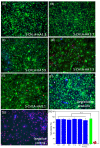Dynamic and Self-Healable Chitosan/Hyaluronic Acid-Based In Situ-Forming Hydrogels
- PMID: 36005079
- PMCID: PMC9407353
- DOI: 10.3390/gels8080477
Dynamic and Self-Healable Chitosan/Hyaluronic Acid-Based In Situ-Forming Hydrogels
Abstract
In situ-forming, biodegradable, and self-healing hydrogels, which maintain their integrity after damage, owing to dynamic interactions, are essential biomaterials for bioapplications, such as tissue engineering and drug delivery. This work aims to develop in situ, biodegradable and self-healable hydrogels based on dynamic covalent bonds between N-succinyl chitosan (S-CHI) and oxidized aldehyde hyaluronic acid (A-HA). A robust effect of the molar ratio of both S-CHI and A-HA was observed on the swelling, mechanical stability, rheological properties and biodegradation kinetics of these hydrogels, being the stoichiometric ratio that which leads to the lowest swelling factor (×12), highest compression modulus (1.1·10−3 MPa), and slowest degradation (9 days). Besides, a rapid (3 s) self-repairing ability was demonstrated in the macro scale as well as by rheology and mechanical tests. Finally, the potential of these biomaterials was evidenced by cytotoxicity essay (>85%).
Keywords: N-succinyl chitosan; aldehyde hyaluronic acid; dynamic bonds; hydrogels; self-healing.
Conflict of interest statement
The authors declare no conflict of interest.
Figures








Similar articles
-
Photocrosslinkable and self-healable hydrogels of chitosan and hyaluronic acid.Int J Biol Macromol. 2022 Sep 1;216:291-302. doi: 10.1016/j.ijbiomac.2022.07.004. Epub 2022 Jul 5. Int J Biol Macromol. 2022. PMID: 35798076
-
Degradable conductive self-healing hydrogels based on dextran-graft-tetraaniline and N-carboxyethyl chitosan as injectable carriers for myoblast cell therapy and muscle regeneration.Acta Biomater. 2019 Jan 15;84:180-193. doi: 10.1016/j.actbio.2018.12.008. Epub 2018 Dec 5. Acta Biomater. 2019. PMID: 30528606
-
3D printable self-healing hyaluronic acid/chitosan polycomplex hydrogels with drug release capability.Int J Biol Macromol. 2021 Oct 1;188:820-832. doi: 10.1016/j.ijbiomac.2021.08.022. Epub 2021 Aug 6. Int J Biol Macromol. 2021. PMID: 34371046
-
Dynamic covalent crosslinked hyaluronic acid hydrogels and nanomaterials for biomedical applications.Biomater Sci. 2022 Nov 8;10(22):6399-6412. doi: 10.1039/d2bm01154a. Biomater Sci. 2022. PMID: 36214100 Review.
-
Polysaccharide-Based In Situ Self-Healing Hydrogels for Tissue Engineering Applications.Polymers (Basel). 2020 Oct 1;12(10):2261. doi: 10.3390/polym12102261. Polymers (Basel). 2020. PMID: 33019575 Free PMC article. Review.
Cited by
-
Characterization of Schiff base self-healing hydrogels by dynamic speckle pattern analysis.Sci Rep. 2024 Nov 14;14(1):27950. doi: 10.1038/s41598-024-79499-5. Sci Rep. 2024. PMID: 39543160 Free PMC article.
-
Artificial Intelligence-Driven Modeling for Hydrogel Three-Dimensional Printing: Computational and Experimental Cases of Study.Polymers (Basel). 2025 Jan 6;17(1):121. doi: 10.3390/polym17010121. Polymers (Basel). 2025. PMID: 39795524 Free PMC article.
-
Evaluation of Cytotoxicity of Hyaluronic Acid/Chitosan/Bacterial Cellulose-Based Membrane.Materials (Basel). 2023 Jul 24;16(14):5189. doi: 10.3390/ma16145189. Materials (Basel). 2023. PMID: 37512462 Free PMC article.
-
Rheological Characterization of Genipin-Based Crosslinking Pigment and O-Carboxymethyl Chitosan-Oxidized Hyaluronic Acid In Situ Formulable Hydrogels.Polymers (Basel). 2024 Sep 15;16(18):2615. doi: 10.3390/polym16182615. Polymers (Basel). 2024. PMID: 39339080 Free PMC article.
-
Exploring the Formulation and Approaches of Injectable Hydrogels Utilizing Hyaluronic Acid in Biomedical Uses.Adv Pharmacol Pharm Sci. 2024 May 27;2024:3869387. doi: 10.1155/2024/3869387. eCollection 2024. Adv Pharmacol Pharm Sci. 2024. PMID: 38831895 Free PMC article. Review.
References
-
- Liu L., Gao Q., Lu X., Zhou H. In situ forming hydrogels based on chitosan for drug delivery and tissue regeneration. Asian J. Pharm. Sci. 2016;11:673–683. doi: 10.1016/j.ajps.2016.07.001. - DOI
Grants and funding
LinkOut - more resources
Full Text Sources

